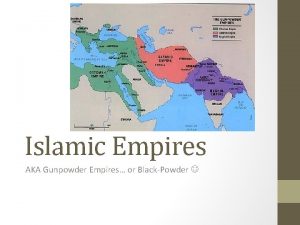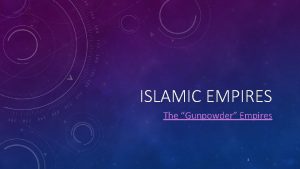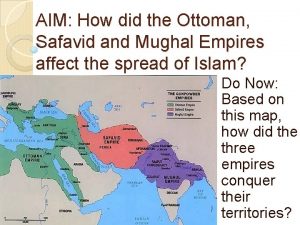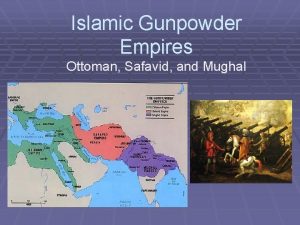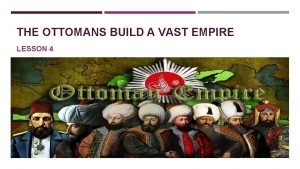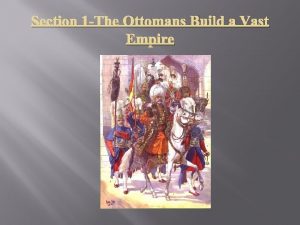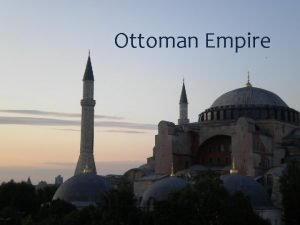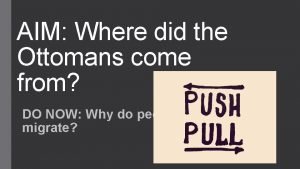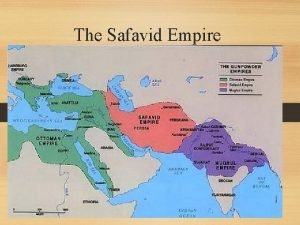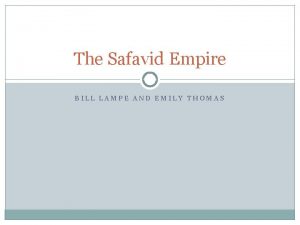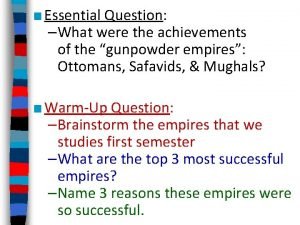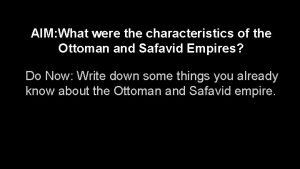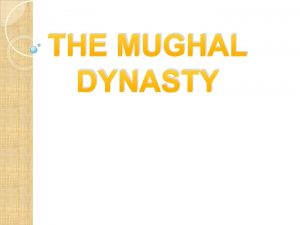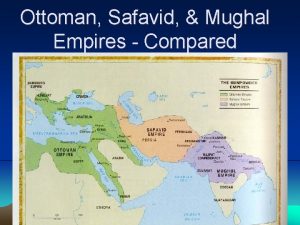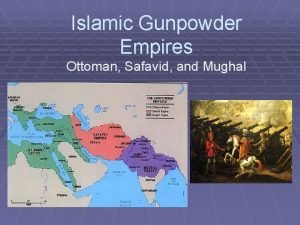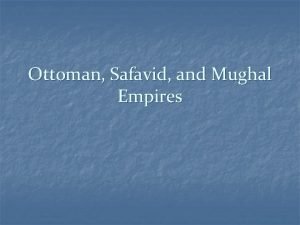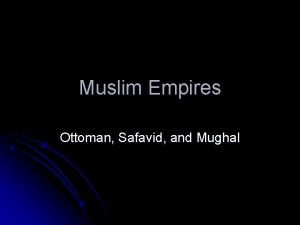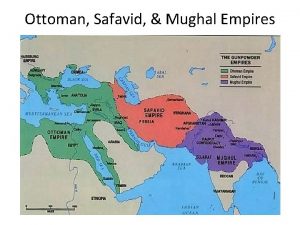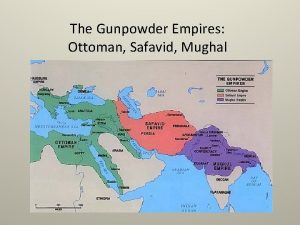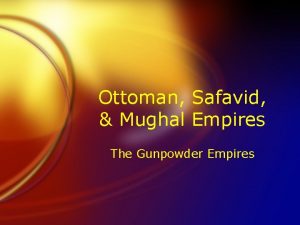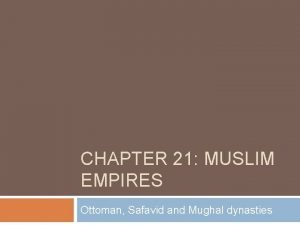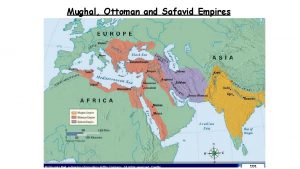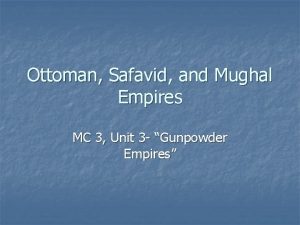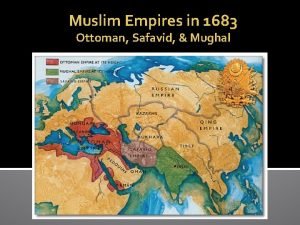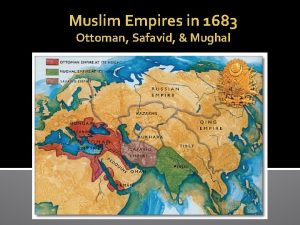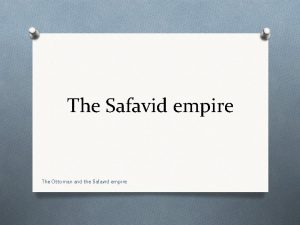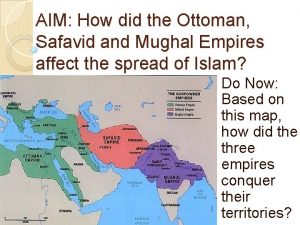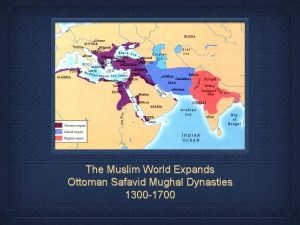Ottoman Safavid and Mughal Empires Ottomans n n



















- Slides: 19

Ottoman, Safavid, and Mughal Empires

Ottomans n n The Osman Turks started on the Anatolian Peninsula in Turkey. They started on land granted them by the Seljuk Turks. They were a pastoral and peaceful people at the start. As the Seljuk Turks began to decline, the Osman began to expand. The Ottoman dynasty began.

Ottoman n In the 14 th century, the Ottomans moved into the Balkans. They took the title of sultan and began to build a strong military by developing the “janissaries. ” Janissary were an elite military guard recruited from Christians, converted to Islam, and trained as foot soldiers or administrators to the sultan.

Ottoman n n April 6, 1253, the Ottoman Turks laid siege to the city of Constantinople. May 29, 1253, Constantinople fell to the Ottoman Turks and Mehmet II. The Turks spent 3 days sacking the city. Many people lost their lives inside the city. The city was later renamed Istanbul.

Ottoman n n Since the times of Mehmet II, Ottoman sultans ruled from the Topkaki Palace in Istanbul. It served as an administrative headquarters and chief residence of the sultan. The private domain of the sultan was called a “harem, ” or “sacred place. ” Here the sultan and his wives lived. Sultans often chose 4 wives as his favorites. When a son became sultan, his mother became queen mother and acted as a major adviser to the throne.

n n n Ottoman The Ottomans were Sunni Muslims. Sultans had claimed the title of caliph since the 16 th century. They were responsible for guiding the flock and keeping Islamic law. In practice, they gave their religious duties to the “ulema”- a group of religious advisors. The ulema were responsible for the legal system and schools for educating Muslims.

Ottoman n n The Ottoman were tolerant of non-Muslims. Non-Muslims paid a tax, but they were allowed to practice their religion or to convert to Islam. Most people in the European areas of the empire remained Christian. In some areas, the large numbers converted to the Islamic faith.

Ottoman n The subjects were divided by occupation. Besides the ruling class, there were 4 main occupational groups: peasants, artisans, merchants, and pastoral peoples. Peasants were farmers; artisans were set up by craft guilds; merchants were exempt from taxes and could amass large fortunes; and pastoral people had their own laws and regulations.

Ottoman n n Other problems arose. The biggest problem was the influence of Western Europe. Western clothes, Western furniture, tobacco and coffee were introduced to the Ottomans. Some sultans tried to fight the trends of Western Europe. One outlawed tobacco and coffee. If he caught anyone taking part in immoral or illegal behavior, he had them immediately executed.

Show Video

Safavid n n n The Safavid Dynasty started with Shah Ismail. He was a descendant of Safi al -Din who had been the leader of a Turkish ethnic groups in Azerbaijan near the Caspian Sea. Under Ismail, the Safavid took control of much of Iran and Iraq

Safavid n n Ismail called himself “shah, ” or king, of the new Persian state. Ismail was a Shiite Muslim. He sent preachers to different areas to convert members of the Ottoman Empire. This led to the massacre of Sunni Muslims when he took Baghdad. Ismail lost a major at Tabriz to Suleiman over religious differences.

Safavid n n The Safavid Empire went from Azerbaijan on the Caspian Sea east to India; along the Persian Gulf and Arabian Sea north to the southern border of Russia. When Shah Abbas died, religious orthodoxy, a pressure to conform to traditional religious beliefs, increased. Women were to give up freedom for a life of seclusion and the wearing of the veil.

n n n Isfahan was the Safavid capital. While under Shah Hussein, it was taken by Afghan peoples. Persia sank into a period of anarchy – lawlessness and disorder. The role of the shah was that of a king. The social structure was Shah, bureaucracy and landed classes, then the common people. The official religion was Shia Islam because the Shiites supported the shahs at first. Safavid

Mughals n n Babur was the founder of the Mogul Empire and united the Hindu and Muslim kingdoms of India. He was a descendant of Timur Lenk, and his mother, from the Mongol conquerors of Genghis Khan. He took the Khyber Pass in northwest India and the city of Delhi in North India. His armies were usually smaller than his opponents but had weapons, artillery, and used them with great effect.

n n Shah Jahan ruled from 1628 to 1658. He ruled using the political system started by earlier Mogul rulers. He expanded the boundaries of the Mogul Empire through campaigns through the Deccan Plateau and Samarkand in the Hindu Kush. He is best known for the Taj Mahal – a mausoleum for his favorite wife, Mumatz Mahal. This is the finest piece of Mogul architecture. It combines Persian, Ottoman, Indian, and Islamic styles. It is located in Agra, India. Mughals

n n Aurangzeb took over from his father, Shah Jahan. He had his brother put to death. He was a devout Muslim and a man of high principle. He tried to eliminate many of the things he thought were social evils in India: suttee (a Hindu practice of cremating a widow on her husband’s funeral pyre), levying illegal taxes, gambling, and drinking. He did not embrace religious tolerance – tried to get Hindu to convert to Islam – and this led to social unrest that made India open to attack from abroad. Mughals

Mughals n n Women in the Mogul Empire had a complex life. Women had played a role in Mogul tribal society – warriors and advisors in political matters. They could own land do business. They also had restrictions of Islamic law: isolation of women was practiced in upper class Hindu families. A lot of Hindu practices went unchanged by Mogul rule

Mughals n n n The Moguls brought together Persian and Indian influences in art and architecture. The Taj Mahal is the greatest example of Mogul architecture. Akbar got Indian artist to use Persian and Indian motifs. The “Akbar style” included humans in action. He encouraged his artist to imitate European art forms, including perspective and lifelike portraits. He commissioned artist from Persia and Europe to come teach Indian artists.
 How did the ottoman safavid and mughal empires arise
How did the ottoman safavid and mughal empires arise Ottoman, safavid, and mughal empires venn diagram
Ottoman, safavid, and mughal empires venn diagram Ottoman safavid and mughal empire map
Ottoman safavid and mughal empire map Ottoman safavid and mughal empire map
Ottoman safavid and mughal empire map Ottoman safavid and mughal empire map
Ottoman safavid and mughal empire map What was the safavid mughal conflict
What was the safavid mughal conflict Impaler state of decay 2
Impaler state of decay 2 Maritime empires vs land empires
Maritime empires vs land empires The ottomans build a vast empire
The ottomans build a vast empire The ottomans build a vast empire
The ottomans build a vast empire Where did the ottomans come from?
Where did the ottomans come from? Where did the ottomans come from
Where did the ottomans come from Safavid empire
Safavid empire Gsprite
Gsprite What empire
What empire Emily lampe
Emily lampe Achievements of the safavid empire
Achievements of the safavid empire Safavid empire achievements
Safavid empire achievements Safavid empire characteristics
Safavid empire characteristics How did mughal attitudes and policies toward
How did mughal attitudes and policies toward
